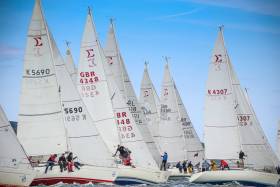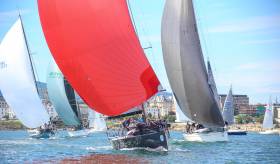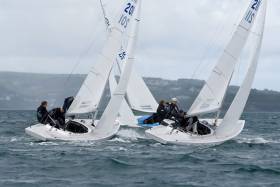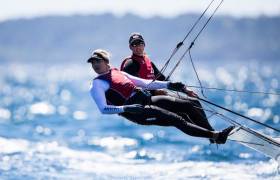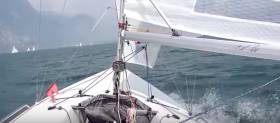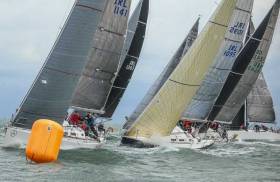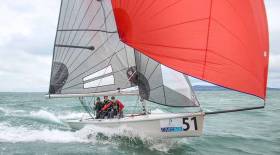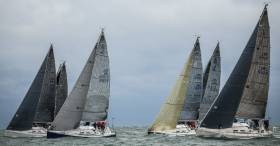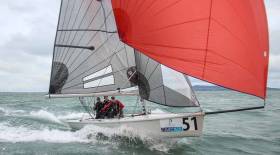Displaying items by tag: Royal Irish Yacht Club
Are you Interested in Sailing or Buying a Sigma 33?
Are you Interested in Sailing or Buying a Sigma 33?
Experience a sail at our Open Morning on Sunday, 24th September 2017 at the Royal St. George Yacht Club
from 9.30–1.00 O’Clock
Followed by finger food in the Club afterwards
For more details call Paddy Maguire 087 2361916 or e- mail [email protected]
More details on the Sigma 33 class from the 2017 season below.
The Volvo Dun Laoghaire Regatta was for the Sigma 33 one design class the third major open Championship of 2017. The season stared in Tarbert, Scotland at the end of May, with the Scottish series with ten competitors and was won by “Mayrise” James Miller of Cove Sailing Club (CCC) with four wins from eight races.
The next event was in Helensburgh in Mid-June for the Class Championships which was won by “ Miss Behavin” Alan Lennox, Helensburgh Sailing Club. The 13–boat fleet completed eight of the ten planned races over the three days.
The Dun Laoghaire Regatta series had 19 entries including nine from the home waters and ten visitors from Northern Ireland, Scotland, England, the Isle of Man and local boats from Arklow and Waterford. The nine race series was dominated the top six visiting boats. Most of them had competed in Tarbert and Helensburgh and benefited from the close racing at both events. It proved very difficult for local boats to break into the top six in any race. The racing was very competitive with places changing on all legs. The Dun Laoghaire Regatta series was won by Alan Harper & Kristy Robertson in “ Mayraise” The Irish Championship were run in conjunction with the regatta and won by Paul Prentice in “ Squawk” from the Royal Ulster Yacht Club.
 Visiting Sigma 33 crews to Dublin Bay in July visiting crews were made up of young and experienced sailors, both men and women. Photo: Afloat.ie
Visiting Sigma 33 crews to Dublin Bay in July visiting crews were made up of young and experienced sailors, both men and women. Photo: Afloat.ie
The Sigma 33’s were the biggest one design keelboat class at the regatta and this added to the more enjoyable competition for competitors. The visiting crews comprised young and experienced sailors, both men and women. It’s on occasions like that that you think of how good Tim Goodbody was in that he was regularly in the top three in such regattas.
It wasn’t all racing and on the Friday night 120 of the fleet held a bicentennial Dinner in The Royal Irish Yacht Club. Prizes were presented to the winners of the day’s racing “ Mayrise” Alan Harper and Kristy Robertson CCC and “Rupert” Richard and Philip Lovegrove of the RStGYC. Thanks to Dun Laoghaire Harbour Company, each boat was presented with a History of the Harbour.
The local fleet will recognise that they need to be more competitive as a fleet if they are to compete more successfully in this type of competitive regatta. There is a big incentive for the Class. In 2018, the Sigma 33 National Championships and Irish Championships will be held in Dun Laoghaire and 2019 is a Dun Laoghaire Regatta year. It is expected that similar entries to 2017 will compete each year. This also provides a great opportunity for young local sailors to acquire a Sigma 33 with a major event in local waters for each of the next two years and discover how successfully they could compete against the visitors and local sailors.
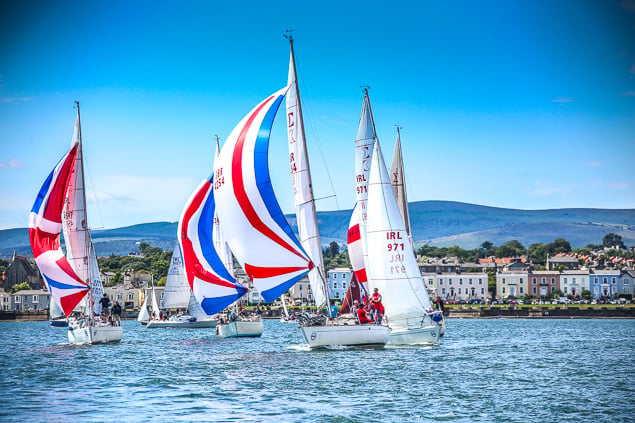 The Sigma 33 Fleet will hold a 'Sigma 33 Morning' on Sunday 24th September 2017 at 9.30am in The Royal St. George in Dun Laoghaire
The Sigma 33 Fleet will hold a 'Sigma 33 Morning' on Sunday 24th September 2017 at 9.30am in The Royal St. George in Dun Laoghaire
As part of the recognition of the changes required to improve our competitiveness, the Sigma 33 Fleet will hold a 'Sigma 33 Morning' to enable anyone interested in buying or sailing on Sigma 33’s to sail on Sunday 24th September 2017 at 9.30am in The George. All are welcome to come down and to join us for finger food afterwards. If you wish to attend please confirm your attendance by contacting Sigma 33 Class Captain Paddy Maguire at [email protected]
With the success of Volvo Dun Laoghaire Regatta 2017 now universally acknowledged in highlighting the developing role of Dun Laoghaire Harbour as a major waterborne recreational centre, it is timely to remember the vital contribution made to the contemporary scene by Dun Laoghaire Marina. Since 2001, it has been quietly yet efficiently getting on with the business of providing the modern facilities which have brought the staging of international big-fleet and keelboat events comfortably within the Harbour’s annual programme. W M Nixon takes up the story
It is a historical fact that when the new Harbour was being planned in Dun Laoghaire 200 years ago, very little if any provision was made to include shore-side facilities in the overall project. The magnificent new granite structure was envisaged purely as an Asylum Harbour to shelter ships waiting to enter or leave the port of Dublin, which in those days was restricted by a shallow entrance unusable at low tide.
Far from providing those on board such vessels with convenient contact with the nearby and initially sparsely-inhabited shore, it was a matter of harbour planning policy that, ideally, there’d be no such contact whatever. Yet even at an early stage of the works, it was increasingly evident that it was potentially a magnificent amenity that would lend itself well to the expanding popular association of the seaside with leisure of all kinds, whether it be simply enjoying the bracing sea air, or interacting more dynamically with nautical activity through boat and water sports.
 The installation of Dun Laoghaire Marina was another stage in providing convenient and safe shoreside access for a harbour in which such access was originally very limited. Photo: Tim Wall
The installation of Dun Laoghaire Marina was another stage in providing convenient and safe shoreside access for a harbour in which such access was originally very limited. Photo: Tim Wall
So although the harbour was not considered finished until 1859, and to some extent has always continued as Work in Progress ever since, by 1859 a fashionable seaside town had already developed beside it, with much emphasis on harbour and sea-related events.
The recent across-the-board success of the four-day Volvo Dun Laoghaire Regatta 2017, with a diverse fleet of 475 boats taking part, was a reminder of how long this supposedly utilitarian harbour has been central to the seaborn leisure activities of the people of Dublin, and particularly those who live in the immediate south county area in what is now Dun Laoghaire-Rathdown.
In addition to the many sailing championships included in the impressive programme for 35 classes, the Regatta celebrated the Bicentenary of the beginning of work on the construction of the harbour in 1817, with 2017’s sailing programme seeing innovative Bicentenary events and special trophies. And of these trophies, arguably the most interesting were framed copies of an engraving showing the first recorded regatta at the harbour, which was staged in 1828, barely eleven year after the massive harbour works were started.
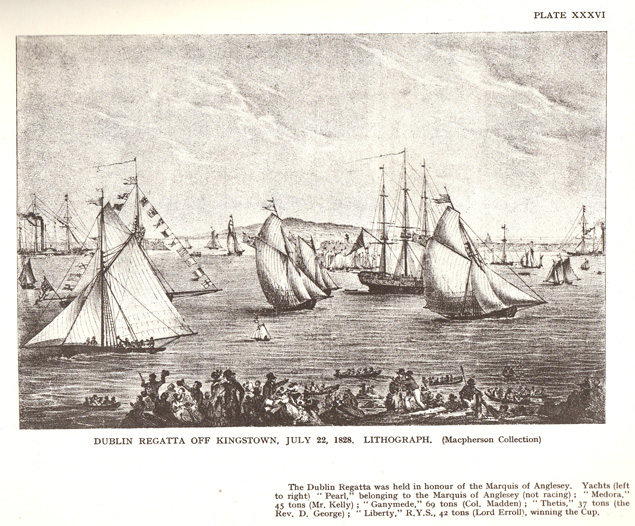 The first Regatta of 1828. Copies of this engraving were awarded as prizes in the Volvo Dun Laoghaire Bicentenary Regatta 2017.
The first Regatta of 1828. Copies of this engraving were awarded as prizes in the Volvo Dun Laoghaire Bicentenary Regatta 2017.
There had been such a demand to utilise the recreational potential of the harbour that many noted racing yachts of the day were prepared to undertake their sailing competition from a harbour which was still a building site, and with very limited shoreside amenities at that. This was to become a theme of the Dun Laoghaire story. In fact, by the time the harbour had achieved the broad outline of its finished form in 1859, the waterfront had acquired the first clubhouse of what became the Royal St George Yacht Club as long ago as 1838, while the Royal Irish Yacht Club, having briefly thrived without a shore-base clubhouse at its foundation in 1831, was revived in 1846 and by 1851 had its magnificent clubhouse, the world’s oldest complete purpose-designed yacht club building, in place on the waterfront.
This process of waterfront development continued with the Edward Yacht Club – now the National Yacht Club – completing the trio of substantial yacht club buildings on the main harbour in 1870, while in modern times it was just over fifty years ago that the Dun Laoghaire Motor Yacht Club came into being on the quayside in the inner Coal Harbour.
These four clubhouses, while diverse in character and style, all share one characteristic. They are miracles of the skillful utilisation of very limited space. For although the town may have grown rapidly because of the existence of the harbour, such was the demand for building space on the fashionable waterfront, and the need for the provision of harbourside roads and a through railway, that the buildings actually serving the needs of ships, seafaring and recreational sailing, were crowded in along a very narrow waterfront strip.
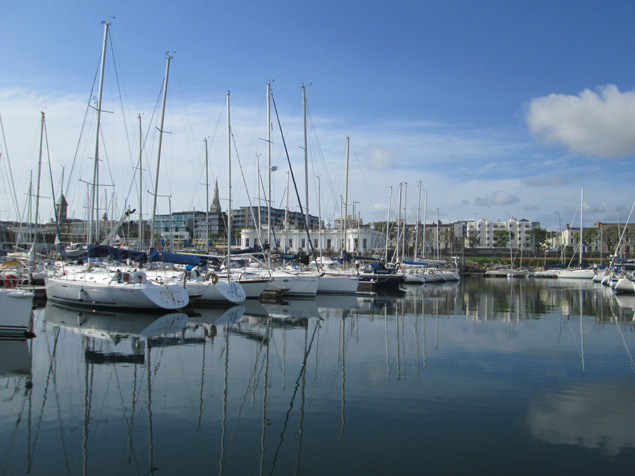 The Royal Irish YC clubhouse of 1851 as seen from the modern marina. This historic clubhouse was built and functioning eight years before the harbour was declared complete.Yet despite the severe limitations of the space available to them, the various waterfront organisations have continued to function and indeed thrive in their activities. So much so, in fact, that it could reasonably be claimed that the outstanding success of the Volvo Dun Laoghaire Regatta 2017, and particularly its Kingstown 200 celebratory highlight, has been a game-changer in reinforcing perceptions of the harbour’s potential.
The Royal Irish YC clubhouse of 1851 as seen from the modern marina. This historic clubhouse was built and functioning eight years before the harbour was declared complete.Yet despite the severe limitations of the space available to them, the various waterfront organisations have continued to function and indeed thrive in their activities. So much so, in fact, that it could reasonably be claimed that the outstanding success of the Volvo Dun Laoghaire Regatta 2017, and particularly its Kingstown 200 celebratory highlight, has been a game-changer in reinforcing perceptions of the harbour’s potential.
There is now definitely a viable future for Dun Laoghaire as a recreational leisure and sporting centre in the broadest sense, whether it be for sailing, rowing, other water sports, or simply enjoying the bracing sea air by walking the splendid main piers which - still largely in their superbly-built original form - have for so long been such an elegant aspect of Dublin Bay that many of us find ourselves thinking of them as natural features.
However, in celebrating the great events of the Regatta of July 6th to 9th 2017, there is one important element in the modern Dun Laoghaire’s provision of facilities which is sometimes overlooked. Perhaps it’s because it simply gets on with what it was planned to do in a professional and unshowy style, for whatever reason these days we tend to take the existence of Dun Laoghaire Marina for granted.
But the harbour’s contemporary year-round sailing programme, and its confident ability to provide totally secure berthing for up to 820 boats of all sizes up to superyachts and record-breaking giant multihulls, is all because of the quiet existence within it of the largest marina in Ireland, which provides hundreds of completely sheltered and fully-serviced pontoon berths in an area whicb formerly only had space for 70 swinging moorings, moorings which were by no means completely sheltered in all conditions.
And yet this facility, still seen as new, is very much of the Harbour in that, of all the diverse maritime facilities on Dun Laoghaire waterfront, it is the Marina which is most water-based. Its footprint ashore is relatively minuscule. It has been allowed just enough space on land for the administrative/reception and services building. But apart from that, its own wide-ranging facilities are completely afloat, as the travel-hoist which serves the fleet is on a different area of Harbour Company land. Although that is leased to the Marina, it is in its turn sub-contracted out to be operated by MGM Boats Ltd, the multi-functional marine trade company which includes boatyard operations within its many areas of expertise.
The long-established yacht clubs may have expanded their originally small sites to became more substantial spaces. But as the aerial photos tellingly reveal, the marina manages to provide its core activities and facilities with a minimal toehold ashore. Yet those core activities and facilities afloat are central to the sailing and boating success of modern Dun Laoghaire, and with the Marina now 16 years old – it officially opened on St Patrick’s Day 2001 – it is time and more to acknowledge its quiet yet very significant contribution.
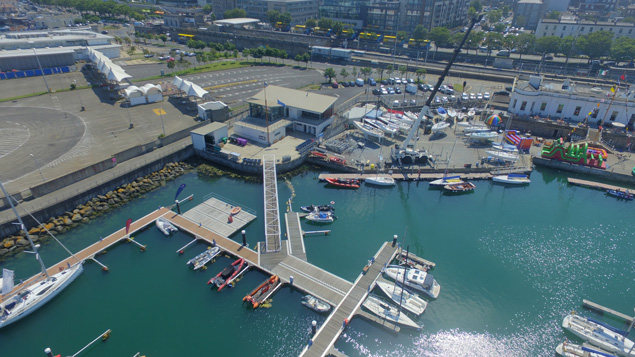 While the Marina is a significant presence afloat, its office footprint on the waterfront is very small, slotted in between the extended hard standing of the Royal Irish YC (right) and the marshalling yards for the former cross-channel ferry service (left).
While the Marina is a significant presence afloat, its office footprint on the waterfront is very small, slotted in between the extended hard standing of the Royal Irish YC (right) and the marshalling yards for the former cross-channel ferry service (left).
That significance can best be put into perspective by putting our minds back to 1986. While Dun Laoghaire Harbour may have been a pioneering facility in the way it developed between 1817 and 1859, by the final decades of the 20th Century it was clearly in need of modernisation, with the urgent need for the addition of properly sheltered pontoon berthing to keep it in line with facilities elsewhere - not just abroad, but also in Ireland, where places like Crosshaven, Howth and Bangor were beginning to enjoy full marina availability.
While Dun Laoghaire sailing enthusiasts of the calibre of Olympic helmsman Jimmy Mooney had been advocating a marina for years in order to offset their harbour’s seriously exposed condition in northeast gales, there was understandable resistance among those who saw the harbour as a beautiful creation in its total and original concept, even if shoreside areas of it were disfigured by the facilities required by ferries operating the cross-channel route to Holyhead.
But then in August 1986, Hurricane Charley struck. Force 12-plus northeasterlies caused enormous damage along Ireland’s East Coast, with Dun Laoghaire experiencing the perfect storm. The harbour was like a giant washing machine, and waterfront and fleet damage and loss was widespread, with classic yachts such as the Dublin Bay 24s and the Dublin Bay 21s – for so long an adornment of the harbour – suffering to such an extent that in effect it marked the end of the Dublin Bay 21s as an active class.
 The destruction wrought by the northeast storms of Hurricane Charley in August 1986 was widespread on Ireland’s East Coast, and the Dun Laoghaire fleet saw boats of all sizes wrecked through broken moorings. This is the remains of the Sisk brother’s X40 Alliance being brought ashore – the caption tells us “this was the less-damaged side”. Photo: David O’Brien/Afloat Magazine
The destruction wrought by the northeast storms of Hurricane Charley in August 1986 was widespread on Ireland’s East Coast, and the Dun Laoghaire fleet saw boats of all sizes wrecked through broken moorings. This is the remains of the Sisk brother’s X40 Alliance being brought ashore – the caption tells us “this was the less-damaged side”. Photo: David O’Brien/Afloat Magazine
After August 1986, the provision of a proper in-harbour marina became a question of “when” rather than “if”. Knowing how long contentious planning matters can take to be resolved in Ireland, it’s actually remarkable that a new marina, located within in-harbour breakwaters of a high standard to match the quality of the main piers, was in being just 15 years and seven months after the balance was tipped in its favour by Hurricane Charley.
Of course there were many other factors involved in the successful implementation of this radical new development, and some people had been working in support of it for many years. As the new and superbly-sheltered amenity became increasingly accepted, supported and used, one of its longterm advocates famously remarked that it had taken 25 years for Dun Laoghaire Marina to become an overnight success.
It may seem strange now that the new marina seemed so strange then, but we have to remember that the Dun Laoghaire Harbour into which it was inserted 16 years ago was a very different place. It was still an active ferry port, with a fully professional harbour staff in charge of the overall administration. But while the clubs were significant employers of professional staff for their facilities afloat and ashore, those employees were in turn answerable to the voluntary democratically-elected officers of each club.
With the marina, however, everything was on a much larger scale. It had to be seen as a commercial proposition, run as a business by competent professionals who were answerable to a management company which in turn was answerable to its shareholders.
And of course the services of the marina were available to any competent boat-owner who was prepared to pay for its excellent facilities. Instead of mainly relying on a club ferry service to get you to and from your boat, you could now step on board as and when you wished. And while the marina management tried to cluster classes and groups of fellow club members in its berthing allocations if possible, it was by no means a requirement, and the relatively closed sailing community had to open its mind and attitudes to newcomers and strangers.
 Hal Bleakley became the first General Manager of the new Dun Laoghaire Marina in 2001. Photo: courtesy Dun Laoghaire Marina
Hal Bleakley became the first General Manager of the new Dun Laoghaire Marina in 2001. Photo: courtesy Dun Laoghaire Marina
It could have been impersonal, but it wasn’t, thanks to the extremely sensible selection by the owners of the marina’s General Managers. There have only been two since 2001, Hal Bleakley who was himself of the Dun Laoghaire sailing community through and through, and Paal Janson, who succeeded him in 2011 after working with him on the small but dedicated marina team for years.
Hal Bleakley was a consummate amateur sailor and race officer whose professional life had been as Maintenance Director for Aer Lingus. It was the perfect CV for a challenging job which simply hadn’t existed in the complicated Dun Laoghaire matrix before.
As for Paal Janson, as you’ll guess he’s of Norwegian descent, but he is very much of Ireland even if there’s a photo of a Janson ancestor’s sailing boat racing at Bergen in the 1920s on the walls of his office, which is more than just an office, it’s a control centre as well, as he can oversee the entire busy marina from it.
 A man and his marina – Paal Janson has been General Manager of Dun Laoghaire Marina since 2011, and has seen it receive new awards and recognition. Photo: David O’Brien/Afloat.ie
A man and his marina – Paal Janson has been General Manager of Dun Laoghaire Marina since 2011, and has seen it receive new awards and recognition. Photo: David O’Brien/Afloat.ie
Like Hal Bleakley, Paal Janson (he tends to be called Paul) brings a very useful professional background, as he was formerly a deck officer in the International Merchant Marine, accustomed to dealing calmly with all sorts of sea-related problems, and in ensuring that things run smoothly without fuss.
With a staff of ten – three for the office and the others working throughout the extensive marina itself – he has been assiduous in keeping Dun Laoghaire marina in its position of high standing among international-level yacht harbours, which is such that it became the first coastal marina among the 23 in the Republic of Ireland to achieve the coveted Five Anchor Award. This was awarded originally in 2008, but more importantly it has been retained ever since, successfully coming through rigorous annual inspections.
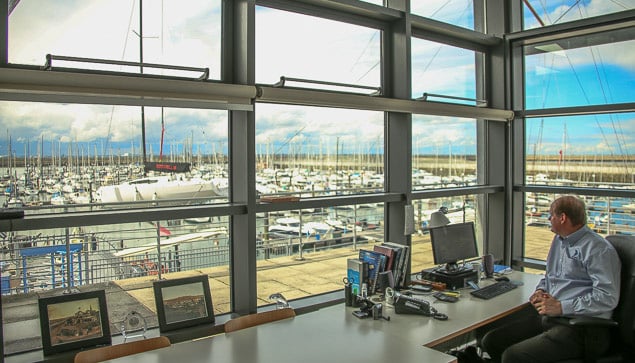 The control centre – the General Manager’s office provides the ultimate view. Photo: David O’Brien/Afloat.ie
The control centre – the General Manager’s office provides the ultimate view. Photo: David O’Brien/Afloat.ie
In retaining the Five Gold Anchors, you are at least dealing with people who understand what a successful marina is trying to do. But not everyone necessarily does so. Thus a challenge which Paal Janson has successfully overcome is getting recognition from Failte Ireland that his marina is a significant player in modern Ireland’s tourism boom.
It has to be said that at times Failte Ireland moves in mysterious ways. You would have though that having a facility of the calibre of Dun Laoghaire Marina on the doorstep of a capital city would have been regarded immediately and enthusiastically as deserving some sort of official accreditation. But it took a while to persuade the powers-that-be a couple of years ago that it was worthy of Failte Ireland’s “Welcome Standard” of accreditation, and in fact 2016 was the first full year in which they enjoyed this official recognition, the first marina in Ireland to do so.
 When you’re running a top marina, all sorts of people come to call…
When you’re running a top marina, all sorts of people come to call…
From a tourism point of view, the presence of the marina can be beneficial in several ways. Apart from its functional value, it is a symbol of peace and prosperity. The very idea of “picturesque poverty” is now rightly regarded as a Victorian obscenity, but the notion of a cruising yacht going harmlessly on her way with her crew enjoying the experience is an extremely reassuring concept in an increasingly disturbed world.
The quiet hint of a comfortable level of prosperity cannot be over-estimated. When Ireland plunged off the economic cliff with the collapse of the Celtic Tiger, tourism numbers plunged. After all, who wants to go on holiday in a country in the depressed grip of an economic recession? But as the green shoots of recovery strengthen, the mood lightens, and people increasingly want to be part of it, so the fact of more visiting boats is in itself an encouragement for further growth.
Currently, it looks as though there’ll be upwards of 600 visiting yachts of all shapes and sizes from more than 20 different countries using Dun Laoghaire Marina this year, including at least half a dozen superyachts. On average, the ordinary cruising boat stays 3 to 4 days, and while their crews find the draw of Dublin’s world-standard tourist attractions a significant appeal, they enjoy returning by DART to a fresh and lively port where the evening sailing programme may be getting under way.
Another particular attraction is that an Airport bus route has a stop within a very short distance ashore. Dun Laoghaire rates highly for its convenience for long-distance crew changes. When you’ve settled into the ways of the sea but realize that dealing with shore realities will shortly be on the agenda, it’s encouraging to know there’s a port ahead where not only can they assist with that, but they can provide helpful printed mini-pocket guides to get the best of Dun Laoghaire while you’re waiting there for your new crew to arrive.
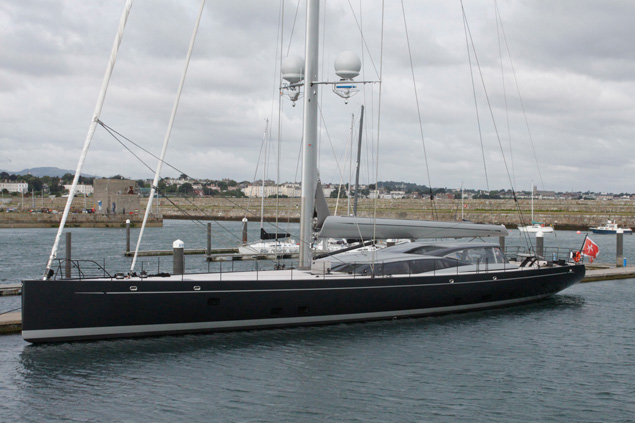 Big boats need grown-up facilities – Dun Laoghaire Marina can provide them
Big boats need grown-up facilities – Dun Laoghaire Marina can provide them
Of course, while the Marina makes a high priority out of being visitor-helpful, it also goes out of its way to be user-friendly for its own berth-holders, and one particular service is relied on by visitors and locals alike. Dun Laoghaire Marina maintains a list of accredited marine specialists and service providers in the immediate neighbourhood, and the welcome feeling of reassurance that such a list is there – even if you don’t have to avail of it – is something which adds to the attraction of the package, while its inclusion in the town’s economic activity and local employment is of real significance as marine experts in all trades from electronics through engineering and boat repair to sail-making are kept busy.
In all, it provides a welcome sense of reaching a centre of excellence when you enter the marina. As visiting cruisers make their way into Dun Laoghaire through late afternoon and early evening, those watching ashore will share the warming experience of another mini-voyage successfully completed. Not that departures and arrivals are restricted to morning and evening. At the height of summer, the Marina sees signs of life 24/7 as boats come and go at all hours depending on their destination and the timing of a favourable tide.
As for those who are actually at home there, Paal Janson has analysed the figure to provide a useful database for anyone studying boat ownership and use. In terms of sail versus power, he reckons in the good times the ratio was 60% sail to 40% power, but there’s no doubt that in recession, there was more of a decline in powerboat ownership than with sailing boats. But as the good time roll again, some of the powerboats appearing are extremely impressive.
Within the sailing boat category, the division between racing and pure cruiser is about 50/50, despite the fact that Dublin Bay Sailing Club’s programme is so firmly embedded in the Dun Laoghaire psyche that you’ll get boats racing with the DBSC fleet on a Thursday night that wouldn’t at all be seen as racers of any kind elsewhere.
It is the range of users for which Dun Laoghaire Marina caters which underlines the breadth of the boat-minded community attracted to its convenient facilities. Since 2007, one of the fixtures of the Marina’s extensive “floating forecourt” has been a Personal Lift which facilitates the Irish Wheelchair Association in getting disabled sailors aboard boats adapted for their use.
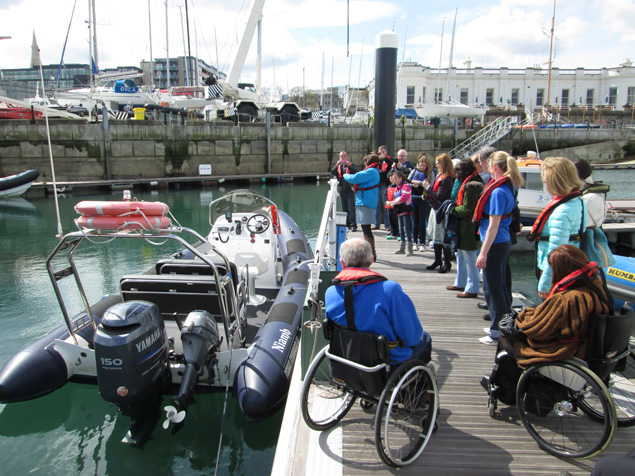 The Irish Wheelchair Association and Dun Laoghaire Marina have combined forces to provide a personal lift and convenient berthing for a specially modified RIB to take wheelchair users to sea, and it is a very frequently-used facility.
The Irish Wheelchair Association and Dun Laoghaire Marina have combined forces to provide a personal lift and convenient berthing for a specially modified RIB to take wheelchair users to sea, and it is a very frequently-used facility.
The fact that this frequently-used setup is in Dun Laoghaire is a reminder of the marina’s inbuilt location advantage over every other marina in Ireland. Dun Laoghaire is conveniently at the heart of one of the largest populations in Ireland, and that population s right beside the sea. So if providers of specialist services of any kind for the boat population seek to increase their activities, they have to remind themselves that ultimately it is the numbers game which will be the key factor in their success.
Thus if you’re going to building up a sailing school – whether inshore or offshore or both – then by being Dun Laoghaire-based, you’re providing your courses within easy reach of a lively, potentially affluent, and numerically large sector of the population.
So although the longest-established of all Dun Laoghaire schools, the Rumball family’s Irish National Sailing School – runs its dinghy courses from facilities within the Inner Harbour beside its HQ, for its most recent ventures into offshore training it uses the marina for berthing requirement. And for several years now the marina has been the base for Ronan O Siochru’s Irish Offshore Sailing, which specialises in this area to such good effect that one of its training yachts, the 37ft Desert Star, was overall winner of the 33-boat Sailing Schools division in the Rolex Fastnet Race 2015.
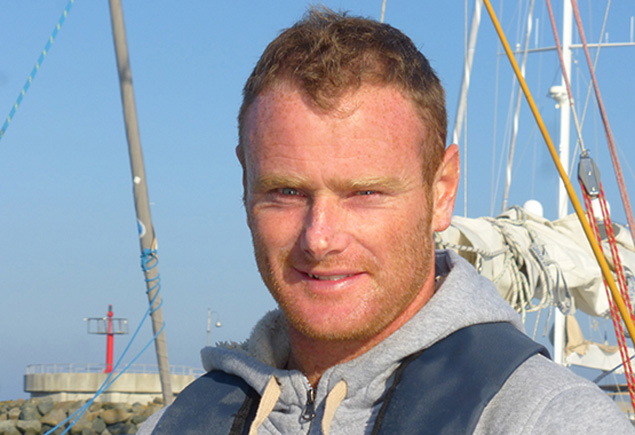 Ronan O Siochru of Irish Offshore Sailing, back in Dun Laoghaire Marineafter his class win in the Rolex Fastnet Race 2015. Photo W M Nixon
Ronan O Siochru of Irish Offshore Sailing, back in Dun Laoghaire Marineafter his class win in the Rolex Fastnet Race 2015. Photo W M Nixon
It was a matter of special pride for the Dun Laoghaire Marina staff that a boat which operated from their base should have achieved such international offshore acclaim, and since then standards have continued to rise, as the Irish National Sailing School are now also very much into the offshore game, with their J/109 lined up – like Desert Star – for participation in the Sailing Schools division in the Rolex Fastnet Race 2017 on Sunday 6th August.
In fact, while IOS’s Desert Star is mainly providing dedicated offshore courses, INSS’s Jedi is into the complete Dublin Bay experience of racing inshore and offshore at the heart of the J/109 and Dublin Bay SC fleet. Thus there was a satisfying sense of completeness at the prize-giving which concluded the Volvo Dun Laoghaire Regatta 2017 on July 9th, when Jedi received her prize as runner-up in the J/109s, as she was also one of the boats receiving the special re-print of the historic engraving of July 1828, recording the very first regatta of all in what had become Kingstown Royal Harbour.
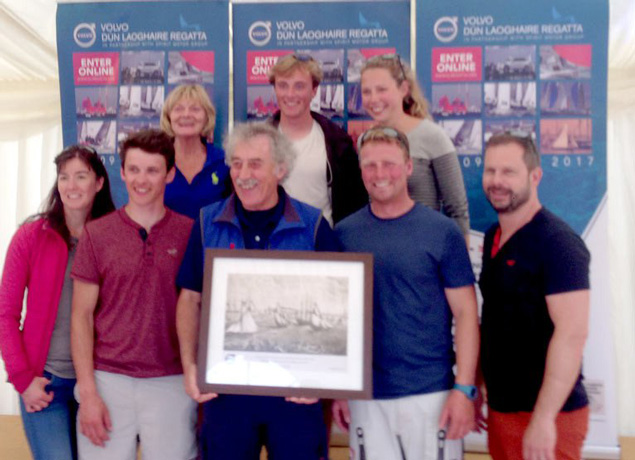 A satisfying sense of completeness. Alistair Rumball (centre) with the special Bicentenary Prize and the Irish National Sailing School crew of Jedi who won it
A satisfying sense of completeness. Alistair Rumball (centre) with the special Bicentenary Prize and the Irish National Sailing School crew of Jedi who won it
It was an image which encapsulated the key elements in the story of the harbour. In the long run, the problems with the shallow entrance to Dublin Port were overcome by dredging development, and the replacement of sailing ships by engine-powered vessels. But Dun Laoghaire remained of use to ships as it had been designated the official cross-channel Ferry Port in 1834, and until warship sizes outgrew it early in the 20th century, it was throughout the later 1800s a naval base, with the advantage of direct rail connection to the main naval base off Cobh in Cork Harbour.
However, although Dun Laoghaire Harbour was obliged to function within the size which had been decided for it in 1817, the increasing size of ships, together with the major changes in shore transport and acceptable road systems, increasingly restricted its potential as a commercial harbour and ferry port.
Then too, the attractive residential nature of Dun Laoghaire’s waterfront terraces of houses was once more in the ascendant. For a period, many had become offices, but with the commercial shipping aspects of harbour activity reducing, recent years have seen the reversion of the harbourside houses – many of them very handsome buildings indeed – to residential use.
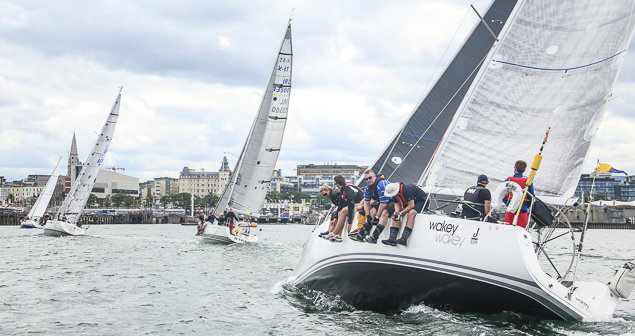 With berthing concentrated in the Marina, and the ferries gone, the close-fought fleet were able to enjoy Dun Laoghaire’s in-harbour finish. Photo David O’Brien/Afloat.ie
With berthing concentrated in the Marina, and the ferries gone, the close-fought fleet were able to enjoy Dun Laoghaire’s in-harbour finish. Photo David O’Brien/Afloat.ie
This has been particularly marked with the new property boom, but it was already under way when the last Holyhead ferry sailed in September 2014, and since then the fact that the Dun Laoghaire waterfront is no longer cluttered with ferry traffic has added to the area’s appeal as somewhere to live and enjoy the sea air and the views of recreational boating activity in the harbour. As for the background, we know that that recreational sailing use started at least as early at 1828, and continues today, busier than ever. But as for ferryport use, that didn’t begin until 1834, and it ended in 2014.
Admittedly the last relics of the ferry era are still much in evidence with the extensive shoreside marshalling yards at St Michael’s Pier and the former Ferry Terminal buildings still very much in existence. But as Dublin Port continues to develop its ferry and cruise liner berthing facilities at top speed, it is surely time for everyone in Dun Laoghaire to accept that their harbour’s future lies in another direction, a healthier direction for a place which is increasingly residential and recreational.
Whatever the outcome, the fact is that Dun Laoghaire Marina is now the main focal point of waterfront activity. In marina terms, it’s a distinctly grown-up sort of place. With its good depths and extensive berthing, it can confidently provide the RNLI with accessible-all-hours berthing for its reserve lifeboats – when Afloat.ie was visiting this week, there were two in port, ready for action at a moment’s notice. And during the winter, naval, coastguard and customs vessels know they can rely on its spaciousness and total shelter when required.
Thanks to its scale, it can cope with big boats and big events too. When Sidney Gavignet and his crew on the MOD 70 Oman Sailing were poised for a challenge at the Round Ireland Record in May 2016, they knew that they could base themselves in Dun Laoghaire marina without being under undue attention while they waited for the ideal conditions to materialise for what was a successful challenge.
 The three MOD 70s in Dun Laoghaire Marina before the Volvo Round Ireland Race in June 2016. Between them, they broke the Round Ireland Record three times in the summer of 2016.
The three MOD 70s in Dun Laoghaire Marina before the Volvo Round Ireland Race in June 2016. Between them, they broke the Round Ireland Record three times in the summer of 2016.
Yet when publicity was sought, as it was for the big boats in the Volvo Round Ireland Race in June 2016, the ideal setting was at the Royal Irish Yacht Club within the shelter of the marina when, despite inclement weather, there was an extraordinary gathering of
legendary race boats and sailing rock stars, all in one place at a berth which would have been untenable had it not been for Dun Laoghaire Marina’s sheltering arms.
So the contribution of the Marina to Dun Laoghaire’s rising status in international sailing deserves to be more widely recognised, as does the Marina’s significant contribution to many aspects of the local economy. But in making themselves and what they do more accessible to the general public, Paal Janson and his long-serving team are walking a tightrope, as they have to ensure urban-centre levels of security for the boats permanently berthed in their facility.
Glamour visitors may come and go, but the longterm berth-holders underpin the entire operation, and their needs are equally important. So perhaps it would be better to acknowledge he success Dun Laoghaire Marina achieves in what it sets out to do, and focus again on one up-coming event in particular. That is the start of the 2017 Rolex Fastnet Race on Sunday August 6th.
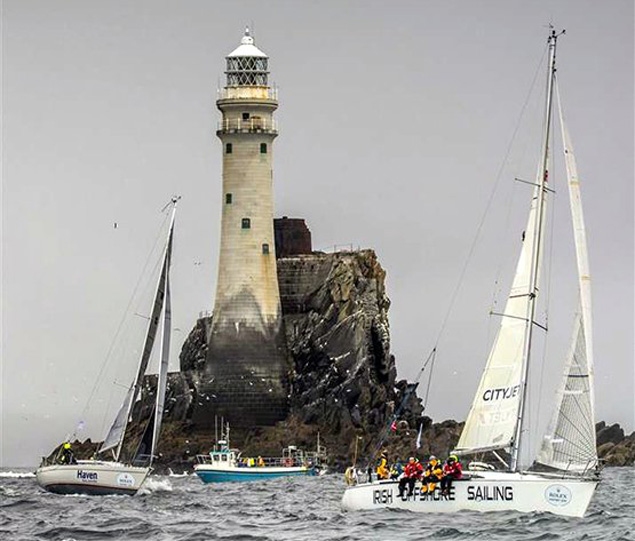 Desert Star from Irish Offshore Sailing in Dun Laoghaire Marina rounding the rock in the Rolex Fastnet Race 2015, on her way to winning the Sailing Schools class of 33 boats…………..
Desert Star from Irish Offshore Sailing in Dun Laoghaire Marina rounding the rock in the Rolex Fastnet Race 2015, on her way to winning the Sailing Schools class of 33 boats…………..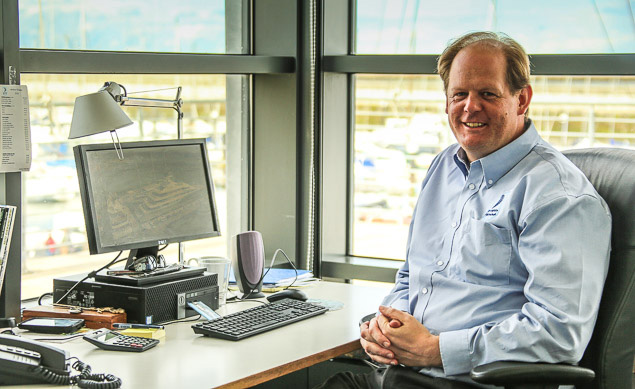 …..which was very pleasing indeed for the Marina General Manager back home. Photo: David O’Brien/Afloat.ie
…..which was very pleasing indeed for the Marina General Manager back home. Photo: David O’Brien/Afloat.ie
Of eleven entries with Irish involvement, six will be boats based in Dun Laoghaire Marina. That is clear evidence of the punch packed by the affluence of the Dun Laoghaire/Rathdown region, and the enthusiasm now being generated within Dun Laoghaire harbour.
And of those six boats, two will be in the Sailing Schools Division - Irish Offshore Sailing’s Desert Star, and Irish National Sailing School’s Jedi. There must be few marinas in Europe, other than those around the Solent, which are sending forth two entries for the Sailing Schools’ prize in the Fastnet. Yet Dun Laoghaire Marina can do it with style, knowing that one of its boats was the overall winner last time round.
Royal St. George's Hegarty Retains Dragon East Coasts
In a repeat of last year's results, the Dragon East Coast Championships at the Royal Irish Yacht Club has been retained by by the Royal St. George Yacht Club's Neil Hegarty in Phantom crewed by David Williams and Kevin O'Boyle. One point behind in the 10–boat fleet was club-mate Martin Byrne's Jaguar with Conor Byrne and John Simms.
Third was Friday's overnight fleet leader Little Fella sailed by Cameron Good, Simon Furney and Henry Kingston. Full results are downloadable below as a pdf file.
Kinsale Yacht Club's Cameron Good sailing with Simon Furney and Henry Kingston lead the Irish East Coast Dragon Championships at the Royal Irish Yacht Club in Dun Laoghaire.
Given Saturday's downpours, the ten boat Dragon fleet got the best of the weather on Friday and sailed two races in light winds and great sunshine.
Good, steering Little Fella, has a four–point cushion over second placed Phantom (Neil Hegarty, David Williams, Kevin O'Boyle) of the RStGYC and Good's own clubmates Mar J (Adrian Bendon, Luke Kedney, Michelle Hayes) in third who both share seven–points overall.
Results are downloadable below
Saskia Tidey’s enthusiasm for racing the 49erFX to Olympic level is such that after she’d exhausted every possibility of finding a sailing partner towards Tokyo 2020 within Ireland, she had to cast the net towards the UK, and linked up with Charlotte Dobson.
Dobson had finished 8th in the 2016 Rio Olympiad sailing with Sophie Ainsworth. Ironically, Charlotte Dobson is also an “outsider”, as she’s from Helensburgh on Scotland’s Firth of Clyde, and went to university in Edinburgh. But whatever their background, and whatever the national colours they’re now sailing under, their first major international debut at the Hyeres championship – after just four months training together – was an immediate breathrough, as they took the Bronze Medal.
By any standards it was a remarkable achievement, after just four months of shared training it was phenomenal, and Saskia Tidey of the Royal Irish Yacht Club is clear winner of our “Sailor of the Month (Olympic)” Award for April 2017.
SB20 Training at the Royal Irish Yacht Club (Gybe Video Here)
SB20 sailor Jimmy Dowling will host a training session on the basic techniques of handling the gennaker on Saturday morning, May 6.
The session is aimed at the less experienced SB20 class members but all are welcome.
A brief lecture, a demonstration and Q & A session commencing at 9.00 will be held in the wet bar (downstairs) at the Royal Irish Yacht Club.
To whet the appetite, a video of Mark Rushall (below) making an immaculate gybe, represents the new standard to be achieved in DBSC racing after this session.
For the summer of 2017 at least, it looks as though Dun Laoghaire Harbour is going to remain free of the threat of the installation of a new liner berth. W M Nixon reckons this provides a unique opportunity for town and harbour to come together as they may have done once upon a time, but have failed to replicate for many years. He provides the background, and makes some suggestions.
The trouble with Dun Laoghaire is that there’s nowhere else quite like it. There isn’t really a truly comparable totally artificial harbour anywhere else on this scale set on the edge of a city, in the midst of an area of general affluence and recreational expectations. It is arguably unique. Nowhere in the world is there a similar setup from which those who hope to manage Dun Laoghaire Harbour effectively might learn lessons on how to make a viable proposition of their port and its future.
Although the original asylum harbour was built by engineer John Rennie and others in majestic style, at the time it had only one simple purpose – to provide shelter for unwieldy sailing ships when Dublin Bay was storm-beset and Dublin Port with its very shallow bar entrance was inaccessible.
The original plans show a sublime indifference to the existence of the little old harbour of Dunleary immediately to the west of the proposed location of the vast new structure. And the little port there has long since disappeared under high value property development to an extent which the early harbour planners cannot have begun to imagine.
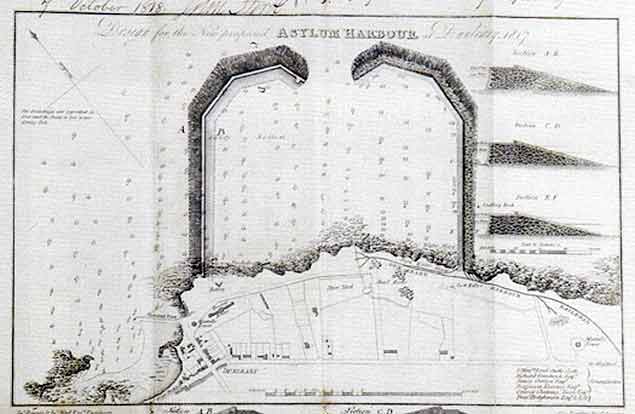 The original plan for the new harbour deliberately excluded the little old harbour of Dunleary to the west, as the new harbour was not intended to provide ship to shore access.
The original plan for the new harbour deliberately excluded the little old harbour of Dunleary to the west, as the new harbour was not intended to provide ship to shore access.
For the idea was not that this would be a port. On the contrary, it would only be a place of temporary shelter in which vessels of importance – particularly those on British government business - would be secure until conditions improved. It was not envisaged that there would be any significant shoreside contact during their short time in what very quickly became Kingstown Harbour.
For of course, no sooner was a harbour under construction, than a town began to develop beside it. It was notoriously un-planned, so much so that fifty years later a critic mocked its name of Kingstown – conferred with a Royal visit in 1821 – by pointing out that far from being a King’s town, it was rather more of a republic of selfish building anarchy.
At the beginning – which we now date to 200 years ago, with the first stone officially laid on May 31st 1817 - significant shoreside development had not been intended. As historian Hal Sisk has pointed out, at no time did the official plans include anything so basic to a proper port town such as warehouses, let alone shipyards or even boatyards. But the basic existence of the harbour in its earliest form by the late 1820s saw the first regatta being staged in 1828. Recreational sailing and the harbour have been intertwined ever since. And the irresistible growth impulse of Kingstown was underlined by the arrival of the railway from Dublin in 1834.
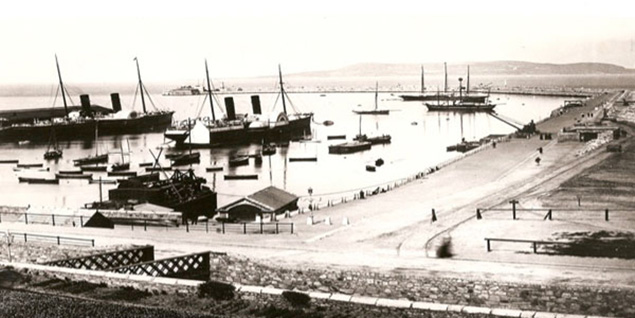 The eastern part of Kingstown harbour at its Victorian high point as a ferry port. The area in the centre, immediately east of Carlisle Pier, will be used for berthing Classic and Traditional Vessels in July during the Volvo Dun Laoghaire Regatta 2017.
The eastern part of Kingstown harbour at its Victorian high point as a ferry port. The area in the centre, immediately east of Carlisle Pier, will be used for berthing Classic and Traditional Vessels in July during the Volvo Dun Laoghaire Regatta 2017.
We take that date of 1834 for granted, but in terms of world railway history, it was very early indeed. And it in turn roped Kingstown into other unplanned developments. As long as the entrance to Dublin port remained dangerously shallow, Kingstown had all the advantages for the rapid development of the cross channel ferry trade. It was all done initially on an ad hoc basis, but it worked for the ferries, while the already proven attractions of the place as an innovative recreational sailing location made it central to world sailing development by the 1860s and 1870s.
So for most of the two hundred years whose history we’ll be celebrating in July, Dun Laoghaire/Kingtown has been struggling with the fact that the basic concept of the harbour - which by its monumental and historic scale still dictates what can be done with it today – was planned with virtually no attention paid to the sea/land interface.
 Despite the restrictions on waterfront space, Kingstown Harbour had become a leading sailing centre by the latter half of the 19th century, as shown in this painting by Richard Brydges Beechey of a Royal St George YC regatta in the 1870s. Courtesy RStGYC
Despite the restrictions on waterfront space, Kingstown Harbour had become a leading sailing centre by the latter half of the 19th century, as shown in this painting by Richard Brydges Beechey of a Royal St George YC regatta in the 1870s. Courtesy RStGYC
Ideally, when the harbour was being built, at least as large an area ashore should have been set aside on the adjacent land to provide for a proper harbour town. But nothing remotely like this was done, and the railway was brought in by the easiest possible shoreside route, thereby putting another barrier between the growing town and the harbor. As a result, the town/harbour relationship has always been problematic. This is particularly so when allied to the fact that areas of conspicuous affluence are almost cheek by jowl with what seem like semi-deprived areas by comparison.
On top of all this, there’s the eternal problem of paying for the harbour’s maintenance. It was superbly built in the first place, but it would be an insult to those early engineers, and their incredibly industrious workers labouring under dangerous conditions, if we failed to maintain the harbour properly in a manner which respects its original concept, while continuing to give it validity for contemporary life.
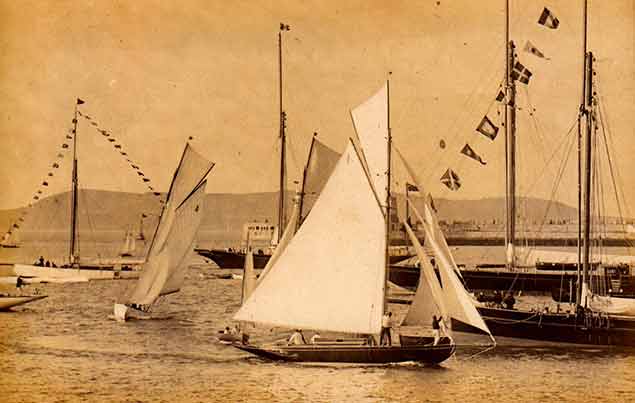 The good old days……..It is the summer of 1901, and the Viceroy Lord Dudley is finishing in-harbour after threading his course through moored yachts to take the win with his new Dublin Bay 25 Fodhla in company with some boats of the new version of the Water Wag class. In second place in the DB 25s is Nepenthe (No 4, Sir H Robinson). Both Dublin Bay 25s were built in Dun Laoghaire by J E Doyle. Photo courtesy Theo Harris
The good old days……..It is the summer of 1901, and the Viceroy Lord Dudley is finishing in-harbour after threading his course through moored yachts to take the win with his new Dublin Bay 25 Fodhla in company with some boats of the new version of the Water Wag class. In second place in the DB 25s is Nepenthe (No 4, Sir H Robinson). Both Dublin Bay 25s were built in Dun Laoghaire by J E Doyle. Photo courtesy Theo Harris
Since the ferries pulled out to re-locate entirely in Dublin Port, taking their guaranteed income stream with them, the struggle has gone on between those who wish to develop any potential the harbour might have for a cruise-liner port of call, and those who feel it should be seen more as a sort of maritime version of the Phoenix Park. They envisage it as a vast breathing space, ultimately maintained by public funds if there’s a shortfall between the income generated by recreational use, and the routine maintenance and administration expenses.
But for the moment, any further development has been postponed awaiting a court case. In it, the point is to be made that making the harbour accessible to functioning liners, with emission-spewing machinery working on a 24/7 basis, will have the effect of polluting the atmosphere in and around the harbour - particularly along the East Pier, the regular promenade for thousands of Dubliners in search of fresh air.
Apparently this point had not been made in the original hearings, so the result is that for the summer of 2017, Dun Laoghaire Harbour will continue as it is at present, with new areas of open sailing space available following the removal of the Stena installations.
 Dun Laoghaire Harbour as it is at present, offering ample space for finishing races. Photo Peter Barrow
Dun Laoghaire Harbour as it is at present, offering ample space for finishing races. Photo Peter Barrow
In the circumstances, surely this is a golden opportunity for the organisers of the Volvo Dun Laoghaire Regatta 2017 to take a look at any section of their enormous and very varied entry list, and select classes which could be given the treat of having at least one of their races finish within the harbour?
Increased ferry traffic was just one of the reasons why the racing for larger craft was obliged to take place outside the harbour. For national and international events, the obsession with committee boat starts and finishes further dictated the move seaward. In Dun Laoghaire, it meant that the connection between the town and active highly-visible sailing became more tenuous than ever.
Yet if we look back to old photos of Dun Laoghaire when it was in the full pomp of its years of Kingstown yachting glory, it was the action in the harbour which brought the whole show to life, and gave everyone a sense of involvement. So let’s hope that the powers-that-be realize that the deferring – permanently we hope – of the proposed liner berth offers an opportunity. Liners Out, Sailboats Back In – that could be the slogan for 2017.
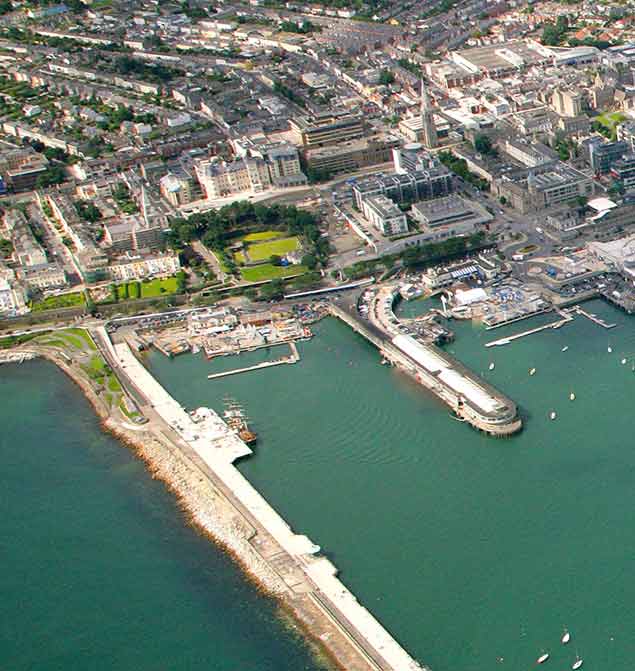 The accessible area off the National YC (photo pre-Lexicon) will provide berthing for Classics and Traditional craft Photo: Peter Barrow
The accessible area off the National YC (photo pre-Lexicon) will provide berthing for Classics and Traditional craft Photo: Peter Barrow
Of course we don’t expect that the really hot classes will agree to finish in-harbour. But there’s something about the Volvo Dun Laoghaire Regatta which attracts a significant segment of participants for whom a bit of fun is central to the sport, and indeed there are many who think that the real sport would be in having to make an in-harbour finish.
The Classics and Traditional Craft will be playing a significant role in this special year. In addition to a dedicated berth with lots of pontoon length being provided for them in the area off the National Yacht Club, the word is that on one day at least, they will have their start in the harbour, highly visible from the East Pier in the area immediately beyond the Carlisle Pier.
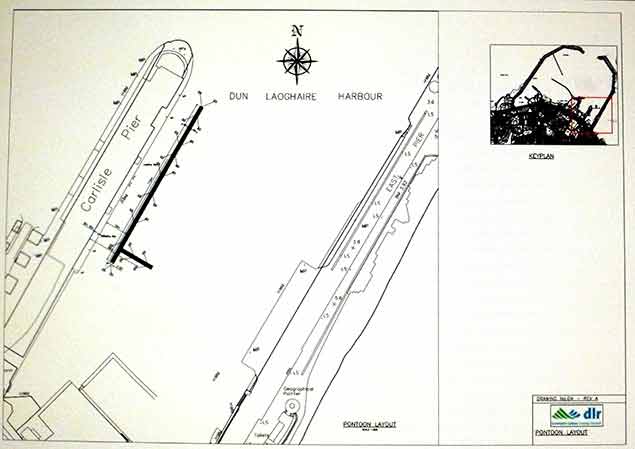 Plan of the proposed pontoon location off the National YC to berth “boats with bowsprits”.
Plan of the proposed pontoon location off the National YC to berth “boats with bowsprits”.
With boat types such as Drascombes coming as a fleet, the notion of the potential accessibility of sailing could be given an enormous boost. What could seem more approachable than the presence of Drascombe man Jack O’Keefe and his mates in friendly competition within the harbour, along with all sorts of other exotic craft such as the Shannon One Designs?
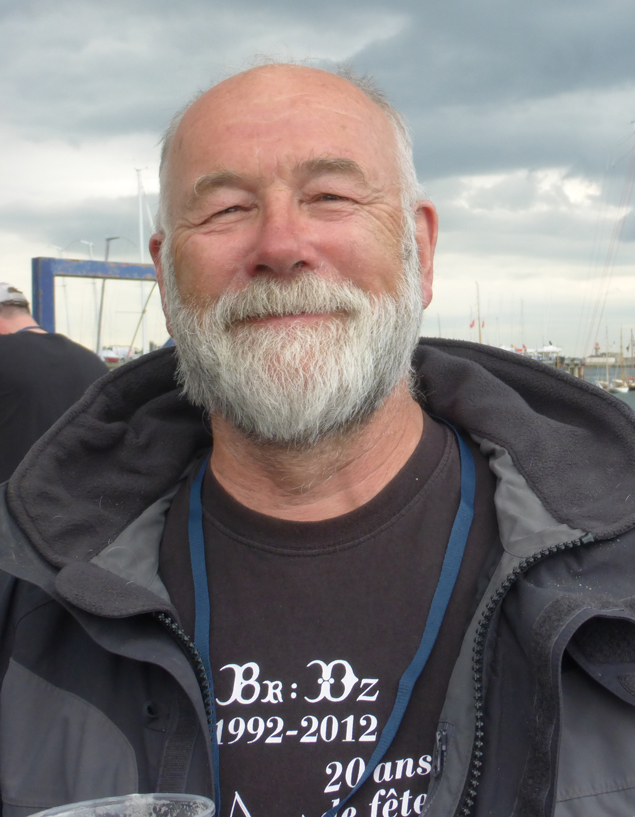 Jack O’Keeffe’s Drascombe is usually seen in distant ports of the west… .Photo: Pierce Purcell
Jack O’Keeffe’s Drascombe is usually seen in distant ports of the west… .Photo: Pierce Purcell
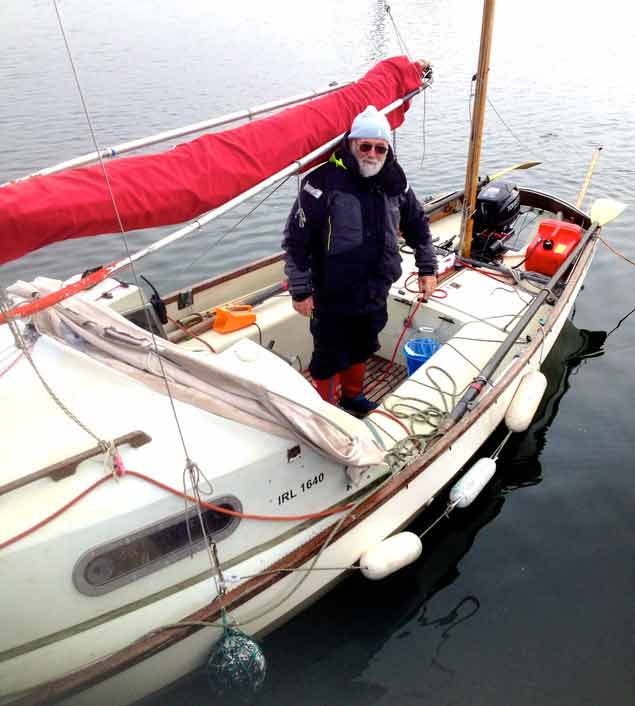 ….but in July 2017 he and his fellow enthusiasts are headed for Dun Laoghaire’s Bicentenary. Photo: Pierce PurcellNot least of such exotica will be the Water Wags, more than ever a part of Dun Laoghaire sailing and Dun Laoghaire Harbour. At this week’s launching of Volvo Dun Laoghaire Regatta ing of Volvo Dun Laoghaire Regatta 2017 in the National Maritime Museum, there was something very touching about the way that the only surviving boat of the original Water Wag class of 1887, the world’s first One Design, had been moved to the centre of the former Mariners Church. The little boat was there in pride of place as the great and the good of Irish sailing networked with each other as plans were revealed of the remarkable amount of behind-the-scenes work that goes into ensuring that this largest of all Irish sailing events runs smoothly.
….but in July 2017 he and his fellow enthusiasts are headed for Dun Laoghaire’s Bicentenary. Photo: Pierce PurcellNot least of such exotica will be the Water Wags, more than ever a part of Dun Laoghaire sailing and Dun Laoghaire Harbour. At this week’s launching of Volvo Dun Laoghaire Regatta ing of Volvo Dun Laoghaire Regatta 2017 in the National Maritime Museum, there was something very touching about the way that the only surviving boat of the original Water Wag class of 1887, the world’s first One Design, had been moved to the centre of the former Mariners Church. The little boat was there in pride of place as the great and the good of Irish sailing networked with each other as plans were revealed of the remarkable amount of behind-the-scenes work that goes into ensuring that this largest of all Irish sailing events runs smoothly.
In the 1890s, there must more than a hundred of these little boats in and around the Greater Dublin area. Even Erskine Childers, with part of the summer of 1894 unfilled in his plans, arranged to have one carted up into the Wicklow Hills to the mountain lake of Lough Dan near the house of his mother’s family, so that he could go sailing when the mood took him.
Yet with the new larger boats introduced in 1900, the little old double-enders just faded away. Fortunately, someone noticed that an odd-looking little canoe-sterned dinghy with a centreplate case on the beach at Malahide was one of the original Water Wags. She was being used for the occasional fishing trip, and it had been a long time since the centreplate had been used for sailing.
She was saved in the nick of time, and is now kept fully rigged in the Maritime Museum. But as the Wag Class historian Vincent Delany assured me at the Volvo reception, she really is absolutely the only surviving original example of a boat which was once so numerous, and fundamental to the global development of sailing.
 The original Water Wags of 1887, the world’s first One Design class. Despite being numerous in the 1890s, the original boat on display in the National Maritime Museum in Dun Laoghaire is now thought to be the only survivor of this historic type.
The original Water Wags of 1887, the world’s first One Design class. Despite being numerous in the 1890s, the original boat on display in the National Maritime Museum in Dun Laoghaire is now thought to be the only survivor of this historic type.
 At the heart of things. The sole surviving Dublin Bay Water Wag of 1887 in the midst of the Volvo Dun Laoghaire Regatta 2017 launch reception in the National Maritime Museum on Wednesday night.
At the heart of things. The sole surviving Dublin Bay Water Wag of 1887 in the midst of the Volvo Dun Laoghaire Regatta 2017 launch reception in the National Maritime Museum on Wednesday night.
Dun Laoghaire Ready to Host Ireland’s Biggest Sailing Fixture
The 2017 Volvo Dun Laoghaire Regatta (VDLR) which is now established as the biggest sailing event in Ireland was launched this evening at the Maritime Museum in Dun Laoghaire. This biennial fixture which is organised by the four Dun Laoghaire waterfront yacht clubs (the Dun Laoghaire Motor Yacht Club (DMYC), the National Yacht Club (NYC), the Royal Irish Yacht Club (RIYC) and the Royal St George Yacht Club (RSGYC) will take place across four days in early July and attracts yachts from all four coasts of Ireland and from England, Scotland, Wales, Northern Ireland and the Isle of Man, and more locally from all the four Dun Laoghaire based yacht clubs.
Speaking at the launch event, David Lovegrove, President, Irish Sailing Association (ISA) said “The VDLR is now firmly established in Ireland’s major sporting calendar and is the biggest participant sporting event in the country, after the city marathons. We are also proud that the VDLR continues to grow and build upon Ireland's international reputation as a quality sports and sailing destination and cements Ireland's reputation as a location for a major international regatta. In addition, local area businesses will benefit considerably from the influx of visitors as they enjoy the superb sailing action in Dublin Bay and a fantastic array of family oriented activities that have been set up on shore.”
The key classes of yachts that will attract the most attention and competition during the Regatta will be the IRC Class 0, Class 1, Class 2, Class 3 and the IRC Offshore Class, who all, already have strong noteworthy entries. In addition, other ‘one design’ classes will include the Beneteau 31.7s, Beneteau 211, Sigma 33, Ruffian 23s, Dragon, RS Elite and the Shipman 28. The dinghy classes will include the GP14, Wayfarer, Squib, Mermaid, Flying Fifteen, Fireball, and single-handed Lasers and Moths.
Most notably this year there will be a Classics division in VDLR 2017 comprising a ‘Kingstown 200’ Anniversary Cup as part of the Dun Laoghaire Harbour Bicentenary Festival from July 6th to 9th 2017.
A monument on the Dún Laoghaire sea front commemorates the first stone of the eastern pier laid by his Excellency Charles Earl Whitworth Lord Lieutenant General and General Governor of Ireland on 31st May 1817, and the visit of King George IV in 1821 (Asylum Harbour of Dunleary was named Kingstown in 1821 and renamed Dun Laoghaire in 1920).
Also speaking at the launch event, Tim Goodbody, Chairman, VDLR 2017 said “The VDLR owes its prominence in European sailing events to a number of factors. One of the core attributes to attracting so many entrants is that it is one of the least expensive sailing events in Europe, thanks to generous sponsorship and support, so providing great value for money for all in the lovely waters of Dublin Bay” .
We also have more than 300 volunteers who give their time and energy to ensure the regatta runs smoothly, as well as the active cooperation of local area businesses and the Dun Laoghaire-Rathdown County Council. And of course the support from the thousands of visitors who come to watch the spectacle and take part in all the family oriented activities in and around Dun Laoghaire.”
“In addition the Regatta brings a significant amount to the local economy. Using the Irish tourism multiplier, the average expenditure per competitor will be €60 per day which for 2,500 competitors will be €150,000 per day and €600,000 for the four day event” added Tim Goodbody.
The VDLR is kindly supported by
• Volvo Car Ireland in partnership with Spirit Motor Group (Title sponsor)
• Dun Laoghaire Rathdown County Council
• Dun Laoghaire Harbour Company
• Failte Ireland
• Collen Construction – New Sponsor
• Helly Hansen
• Royal Marine Hotel
• Bretzel Bakery
• Dubarry
Should Dublin Bay Sailing Club Cruisers Zero & One Merge?
With just over six weeks to the Sherry Fitzgerald sponsored Dublin Bay Sailing Club season the stand–out class of the year looks like Cruisers One where a 20–boat fleet has 13 J/109s among its number. It's an impressive result that bodes well for a very competitive season but in the neighbouring big boat class should something be done to assist falling numbers in Cruisers Zero?
A story this week on Afloat.ie shows George Sisk's Wow from the Royal Irish Yacht Club is on the market. With only four other entries presently in DBSC Cruisers Zero is it now time to dispense with a Cruisers Zero class on Dublin Bay and rearrange the bands to take some lower–rated Cruisers One boats back into Cruisers Two?
Such a scenario is unlikely with the news that Sisk's WOW will be campaigned fully this season and a new Sisk forty footer is in the wings. In fact, there is also the possibility that Cruisers Zero could reach six boats this season with another new boat – yet to be announced – coming into the Bay.
There is also talk of DBSC moving the Cruisers One band lower to move some Cruisers One boats into Cruisers Zero but is that the answer?
Cruisers Zero was never that particularly strong in Dublin Bay and generally came about to ensure they got decent length races as the Cruisers One boats were considerably slower. However with the ever increasing speed of Cruisers One boats the gap in elapsed time between Cruisers Zero and Cruisers One has been reducing considerably.
 Cruisers Zero Farr 42 Wow is for sale but will be replaced with a similar sized boat Photo: Afloat.ie
Cruisers Zero Farr 42 Wow is for sale but will be replaced with a similar sized boat Photo: Afloat.ie
Cruisers One, spearheaded by the J109 designs, is clearly the strongest class in DBSC and likely in the country. Since the J109 class moved to non–overlapping jibs and consistently updated their sail wardrobes with the latest in sail technologies, they have been getting quicker and quicker.
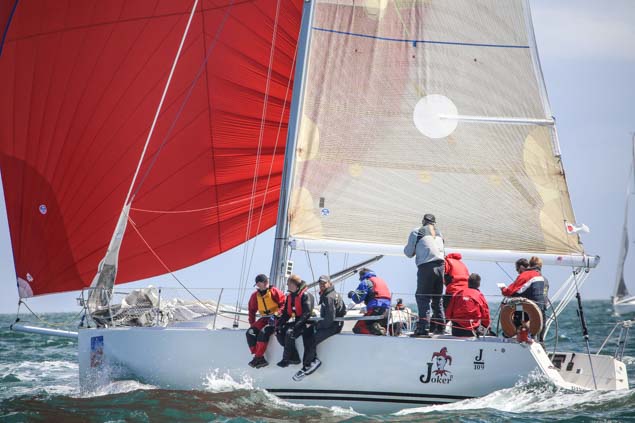 ICRA Boat of the Year, Joker 2, a J109 from the Royal Irish Yacht Club. Photo: Afloat.ie
ICRA Boat of the Year, Joker 2, a J109 from the Royal Irish Yacht Club. Photo: Afloat.ie
Three of the last four ICRA championships in Cruisers One have been won by J109’s including the last two years (Joker II) and the 2016 ICRA Boat of the Year is also a J109 (Joker II). A J109 also was a class winner in the Round Ireland race 2016 (Storm). The J109 class has pushed others in Cruisers One to up their game and now we see both the Archambault 35s Gringo and Adrenalin becoming much more competitive, along with the XP33 Bon Exemple that has gone through many changes over the last few year (symmetric to Asymmetric and back again, lowering their rating). Add to this Paul O'Higgins mighty Rockabill VI, the JPK 10.80, and Cruisers One is the strongest it has ever been.
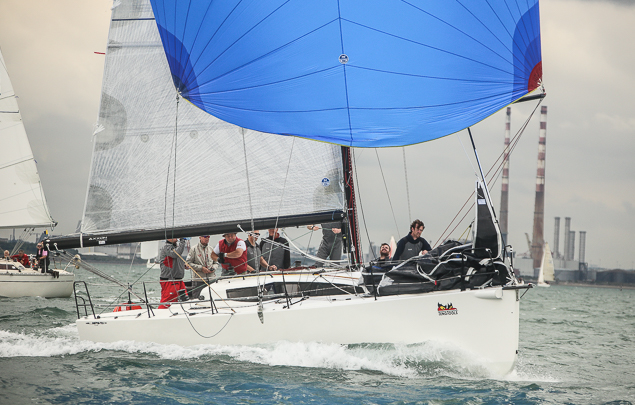 Paul O'Higgins mighty Rockabill VI, the JPK 10.80 design will be unstoppable in heavy airs. Photo: Afloat.ie
Paul O'Higgins mighty Rockabill VI, the JPK 10.80 design will be unstoppable in heavy airs. Photo: Afloat.ie
At the start of last season Tim Goodbody brought in the J109 White Mischief and two further J109’s have entered the fleet in the last six months, Andrew Algeo's Juggerknot and Andrew Craig's Chimeara. All three are seasoned campaigners and will surely drive the fleet further.
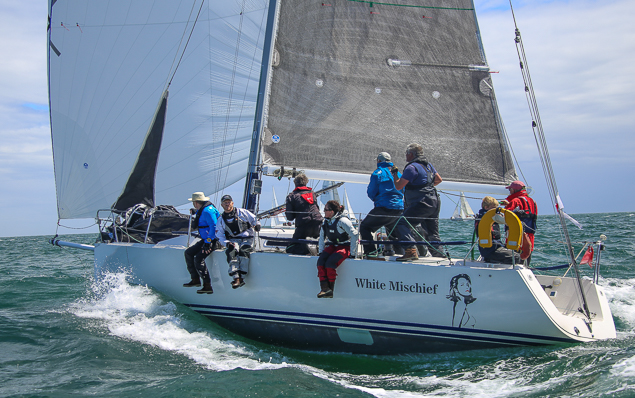 Recent arrival – Tim Goodbody's White Mischief J109 was immediately competitive Photo: Afloat.ie
Recent arrival – Tim Goodbody's White Mischief J109 was immediately competitive Photo: Afloat.ie
 The A35 Gringo has a flatter stern and quick dead downwind. Photo: Afloat.ie
The A35 Gringo has a flatter stern and quick dead downwind. Photo: Afloat.ie
So who will be on the DBSC podiums this year in Cruisers One and also Cruisers One at ICRAs? With 13 J109’s competing surely the podium will be stacked with these 15–year–old designs? They are extremely competitive in lighter airs and can hold their own when the breeze gets up. Their only weakness is running in stronger winds where the lighter, and flatter sterned modern designs, like the A 35’s and XP 33’s can pull their poles back and go straight downwind, whereas the asymmetric J109’s have to do higher angles.
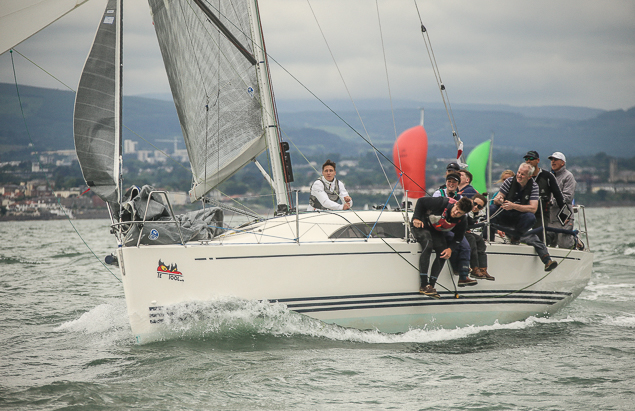 XP33 Bon Exemple – different spinnaker configurations. Photo: Afloat.ie
XP33 Bon Exemple – different spinnaker configurations. Photo: Afloat.ie
If, however, the winds stay stronger for a whole series, like ICRA's 2015, it will be very hard to beat Rockabill VI. This boat is extremely powerful and will go upwind and downwind much faster than the rest of the fleet in a breeze, even taking into account her higher handicap. However it appears she has a weakness in light airs and one day of these conditions in a series might be a problem for her.
Three in a Row for Joker II at ICRAs?
Among the J109’s the top performer from 2016, John Maybury's Joker 2 is going for three in a row at ICRA's having won in 2015 and 2016. She will not have it all her own way however as Tim Goodbody's White Mischief and Pat Kelly's Storm are always very competitive. The newly arrived Chimeara and Juggerknot might also have something to say. The A35 Gringo has shown a lot of form as has Bon Exemple. At ICRAs you will also likely be seeing the A35 Fools Gold of Rob O'Connell in contention as he has done in the last two events.
Packed Season
2017 is set to be a very interesting year for this ever strengthening class with 3 large events in Ireland for them to battle it out. The ICRA Championships in Cork Harbour in June, ten days later, Sovereigns Cup in Kinsale, and a few weeks after that Dun Laoghaire Regatta Some may also venture to Tarbert in Late May, Calves Week in Early August and Abersoch week in Late August. There are plenty of good events available and some great racing ahead. Allied to all of this a great regular racing scene in Cruisers One in the DBSC series.
The Graham Elmes Memorial Trophy will be presented to Cork Harbour's Dave Barry and the crew of SB20 Lia as winners of the 2016 Travellers Trophy at Friday night's SB20 Annual Class Dinner at the Royal Irish Yacht Club in Dun Laoghaire.
The class trophy is awarded to the top ranking boat across all regional events including the National Championships.
The 2018 SB20 European Championships will be hosted by the Royal Irish Yacht Club and new class captain Ger Demspey is promising an exciting season ahead on Dublin Bay.
There are still a few tickets available for Friday's dinner and can be booked directly with the RIYC.


























